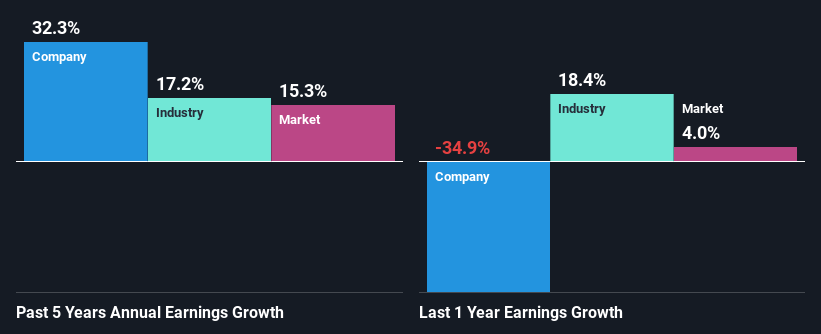Are Robust Financials Driving The Recent Rally In Winnebago Industries, Inc.'s (NYSE:WGO) Stock?
Most readers would already be aware that Winnebago Industries' (NYSE:WGO) stock increased significantly by 13% over the past three months. Since the market usually pay for a company’s long-term fundamentals, we decided to study the company’s key performance indicators to see if they could be influencing the market. In this article, we decided to focus on Winnebago Industries' ROE.
ROE or return on equity is a useful tool to assess how effectively a company can generate returns on the investment it received from its shareholders. In short, ROE shows the profit each dollar generates with respect to its shareholder investments.
See our latest analysis for Winnebago Industries
How Do You Calculate Return On Equity?
ROE can be calculated by using the formula:
Return on Equity = Net Profit (from continuing operations) ÷ Shareholders' Equity
So, based on the above formula, the ROE for Winnebago Industries is:
19% = US$255m ÷ US$1.4b (Based on the trailing twelve months to May 2023).
The 'return' is the amount earned after tax over the last twelve months. That means that for every $1 worth of shareholders' equity, the company generated $0.19 in profit.
What Is The Relationship Between ROE And Earnings Growth?
We have already established that ROE serves as an efficient profit-generating gauge for a company's future earnings. Based on how much of its profits the company chooses to reinvest or "retain", we are then able to evaluate a company's future ability to generate profits. Generally speaking, other things being equal, firms with a high return on equity and profit retention, have a higher growth rate than firms that don’t share these attributes.
Winnebago Industries' Earnings Growth And 19% ROE
To start with, Winnebago Industries' ROE looks acceptable. Further, the company's ROE is similar to the industry average of 19%. Consequently, this likely laid the ground for the impressive net income growth of 32% seen over the past five years by Winnebago Industries. We reckon that there could also be other factors at play here. For example, it is possible that the company's management has made some good strategic decisions, or that the company has a low payout ratio.
As a next step, we compared Winnebago Industries' net income growth with the industry, and pleasingly, we found that the growth seen by the company is higher than the average industry growth of 17%.
The basis for attaching value to a company is, to a great extent, tied to its earnings growth. It’s important for an investor to know whether the market has priced in the company's expected earnings growth (or decline). Doing so will help them establish if the stock's future looks promising or ominous. Is Winnebago Industries fairly valued compared to other companies? These 3 valuation measures might help you decide.
Is Winnebago Industries Using Its Retained Earnings Effectively?
Winnebago Industries' three-year median payout ratio to shareholders is 7.3%, which is quite low. This implies that the company is retaining 93% of its profits. So it seems like the management is reinvesting profits heavily to grow its business and this reflects in its earnings growth number.
Moreover, Winnebago Industries is determined to keep sharing its profits with shareholders which we infer from its long history of nine years of paying a dividend. Looking at the current analyst consensus data, we can see that the company's future payout ratio is expected to rise to 10% over the next three years. However, the company's ROE is not expected to change by much despite the higher expected payout ratio.
Conclusion
On the whole, we feel that Winnebago Industries' performance has been quite good. Particularly, we like that the company is reinvesting heavily into its business, and at a high rate of return. Unsurprisingly, this has led to an impressive earnings growth. That being so, a study of the latest analyst forecasts show that the company is expected to see a slowdown in its future earnings growth. To know more about the latest analysts predictions for the company, check out this visualization of analyst forecasts for the company.
Have feedback on this article? Concerned about the content? Get in touch with us directly. Alternatively, email editorial-team (at) simplywallst.com.
This article by Simply Wall St is general in nature. We provide commentary based on historical data and analyst forecasts only using an unbiased methodology and our articles are not intended to be financial advice. It does not constitute a recommendation to buy or sell any stock, and does not take account of your objectives, or your financial situation. We aim to bring you long-term focused analysis driven by fundamental data. Note that our analysis may not factor in the latest price-sensitive company announcements or qualitative material. Simply Wall St has no position in any stocks mentioned.

